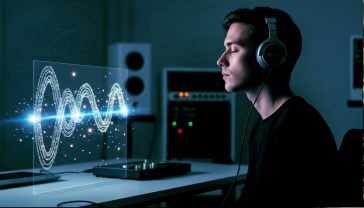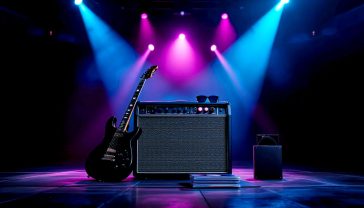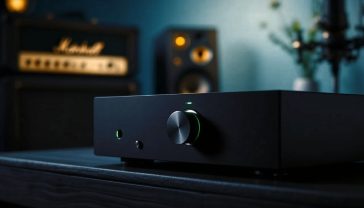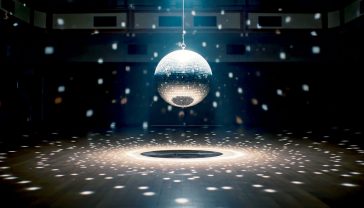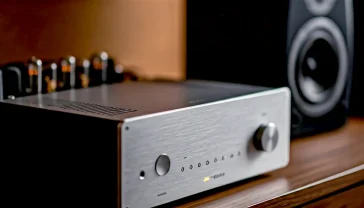The Quiet Revolution: The Story of How Silent Discos Conquered Britain
From Glastonbury fields to city streets, the silent disco is a UK phenomenon. Discover the surprising history and clever tech behind the headphone party.

This post may contain affiliate links. If you make a purchase through these links, we may earn a commission at no additional cost to you.
Picture the scene. It’s late at night at a buzzing UK music festival. Thousands of people are packed into a field, arms in the air, dancing their hearts out. Their faces are a mixture of pure joy, concentration, and laughter. But something’s odd. There’s no earth-shaking bass, no thumping beat rolling across the valley. In fact, apart from the shuffling of feet and the sound of thousands of people singing badly out of tune, it’s almost completely silent.
Welcome to the wonderfully weird world of the silent disco.
It’s a concept that sounds like a joke at first: a party where everyone wears wireless headphones. Yet, this quiet revolution has become a massive part of British culture. From the muddy fields of Glastonbury to freshers’ week parties, city-centre walking tours, and even weddings, headphones are replacing loudspeakers.
But how did this strange idea go from a niche novelty to a mainstream marvel? What makes it so special? It’s not just about keeping the neighbours happy. The story of the silent disco is a fascinating tale of eco-activism, clever technology, and the simple human desire to connect and have a good time—just in a slightly different way. It’s a story about finding a shared experience in individual moments of sound.
So, grab a pair of imaginary headphones, and let’s dive into the rise of the silent disco.
What on Earth Is a Silent Disco? The Nuts and Bolts
Before we get into the history and the hype, let’s get the basics straight. What exactly is a silent disco, and how does it work?
The Simple Explanation
Imagine you and your mates all want to listen to music, but you can’t agree on a playlist. You love cheesy 80s pop, your best friend is into heavy drum and bass, and someone else just wants to chill out to some indie tunes.
A silent disco solves this problem instantly.
It’s an event where people listen to music through special wireless headphones instead of a traditional speaker system. Usually, there are two or three different DJs or playlists broadcasting at the same time on different channels. You get to choose which one you listen to simply by flicking a switch on the side of your headphones.
The best bit? The headphones light up with a colour—usually blue, green, or red—to show which channel you’re on. This means you can see what everyone else is listening to. You can find your tribe dancing to the same beat or laugh at the person flailing wildly to a completely different rhythm. If you want to chat with someone, you just take your headphones off. The room falls silent, and you can have a normal conversation without shouting over a booming sound system.
It’s a party that’s both personal and public, loud and quiet, all at the same time.
The Detailed Techy Bit
So, how does the magic happen? The technology behind a silent disco is actually quite simple and clever, a bit like a mini radio station just for the party.
- The Music Source: It all starts with the DJs. You’ll typically have two or three DJs playing their sets just like they would at a normal club. Their mixing desks are plugged not into massive speakers, but into a special piece of kit called an FM transmitter.
- The Transmitter: This little box is the heart of the operation. It takes the audio signal from the DJ’s decks and broadcasts it as a low-power FM radio signal. Each DJ has their own transmitter set to a different frequency, or channel. The range of these transmitters can vary, but they can easily cover a large hall or a festival tent.
- The Headphones: These aren’t your standard Bluetooth headphones. Each pair is a wireless receiver designed to pick up those specific FM signals. On the side of the headphones, there’s a switch that lets you flick between the different channels the transmitters are broadcasting. There’s also a volume dial, so you’re in complete control of how loud your music is. The LED lights on the side change colour depending on which channel is selected, creating that amazing visual spectacle of a crowd glowing in different colours.
The result is a surprisingly high-quality audio experience. Because the sound is being beamed directly into your ears, it’s crystal clear. There’s no echo from the venue’s walls or distortion from speakers being pushed too hard. It’s your own personal, high-fidelity gig.
A Surprisingly Long History: From Sci-Fi to Glastonbury Fields
You might think silent discos are a modern invention, a product of the 21st century. But the idea of a personal, headphone-based experience has been around for decades, popping up in science fiction, environmental protests, and finally, the UK’s legendary festival scene.
The Seed of the Idea: A Sci-Fi Future
The earliest known depiction of something resembling a silent disco comes from a 1969 Finnish science fiction film called Ruusujen Aika, which translates to A Time of Roses. In one scene, the characters are shown at a futuristic party, all wearing headphones and dancing together in silence. It was a strange, forward-thinking vision of how technology might change social gatherings. For years, though, that’s all it was—an idea.
The Eco-Warriors’ Secret Weapon
The first real-world use of the concept didn’t come from the party scene, but from a much more serious place: environmental activism. In the early 1990s, eco-activists in the UK wanted to hold outdoor parties and gatherings without causing noise pollution that would disturb local wildlife (or attract unwanted attention from the authorities).
Their solution was ingenious. They used portable radio transmitters and wireless headphones to create silent raves. These early events were a far cry from the slick, professional setups we see today. They were DIY, grassroots affairs, but they proved the concept worked. People could gather, dance, and share a moment without leaving a massive sonic footprint.
Glastonbury and the Noise Curfew
The moment the silent disco truly arrived in the UK’s cultural consciousness can be traced to one place: Glastonbury Festival.
For years, festivals had a massive problem with noise curfews. Local councils, trying to keep nearby residents happy, would impose strict limits on how late amplified music could be played. This often meant the party had to stop just when it was getting good.
In the early 2000s, festival organisers were looking for a way around this. The story goes that Glastonbury’s Emily Eavis first saw a silent disco on a trip to Holland. She realised it was the perfect solution. In 2005, the festival decided to give it a go. Late at night, in the Left Field area, they handed out headphones and let people party on into the wee hours.
It was an instant sensation. Festival-goers loved the novelty, but they also loved that the party didn’t have to stop. The sight of a whole field of people dancing under the stars in near-silence became one of the festival’s iconic images. The silent disco had found its spiritual home.
From there, it exploded. Other festivals like Bestival and Reading quickly adopted it. It became a rite of passage for students during freshers’ week. Companies started hiring out kits for weddings and private parties. The silent disco wasn’t just a clever way to beat a noise curfew anymore; it was a unique and desirable experience in its own right.
The Silent Disco Experience: Why People Actually Love It
So, we know how it works and where it came from. But why has the silent disco become so enduringly popular? What is it about this weird and wonderful experience that keeps people coming back for more? It turns out there are some powerful social and psychological reasons behind the hype.
1. It’s Surprisingly More Social
This is the biggest paradox of the silent disco. You’d think an event where everyone is locked in their own world of sound would be incredibly anti-social. But it’s often the exact opposite.
In a traditional club, trying to have a conversation is a nightmare. You end up screaming “WHAT?” into your friend’s ear all night, getting a sore throat in the process. At a silent disco, communication is easy. You just slide your headphones off, and suddenly you’re in a quiet room. You can chat, laugh, and order a drink without a single raised voice.
There’s also a hilarious, communal aspect to it. Watching a sea of people dance to different rhythms is genuinely funny. You’ll see one group doing the Macarena to some 90s pop, while another is head-banging to rock anthems. This shared absurdity brings people together. You can switch channels to join in with a song your friends are loving, or just stand back and enjoy the bizarre, silent ballet unfolding before you.
2. You Are the DJ (Sort Of)
We’ve all been there. You’re at a party, and the music is just… wrong. You want to dance, but the DJ is stuck in a genre you can’t stand.
A silent disco gives the power back to the people. With two or three channels to choose from, you’re almost guaranteed to find a vibe that suits you. If you get bored of one song, you can instantly switch to another. It eliminates the age-old argument over the party playlist.
This freedom of choice makes everyone feel included. It doesn’t matter if your musical tastes are completely different from your friends’; you can all be on the same dancefloor, having your own perfect night out, together. DJs can also see which channel is the most popular by looking at the colours of the headphones, leading to a fun, friendly battle to win over the crowd.
3. The Sound is Incredible
Venue acoustics can make or break a gig. In a big, echoey hall or an outdoor space, sound can get lost, distorted, or just plain muddy.
With a silent disco, the sound quality is pristine. The music is beamed directly into your ears, creating a rich, immersive experience. You can hear every beat, every lyric, every subtle layer of the music. And because you control your own volume, you can have it as loud or as quiet as you like. No more ringing ears the next day (unless you really crank it up, of course). This is a huge plus for people who love music but hate the ear-splitting volumes of some clubs and concerts.
4. The Sheer Novelty of It All
Let’s be honest: a big part of the appeal is that silent discos are just plain different. They’re a fun, memorable novelty. The experience of putting on the headphones and suddenly being transported into a world of sound is a magical moment. Taking them off again and being plunged back into silence is equally surreal.
This unique contrast between loud and quiet, personal and public, makes for an unforgettable night. It’s an experience you’ll talk about the next day, and for that reason, it has become a go-to choice for everything from milestone birthday parties to corporate events. It’s a guaranteed ice-breaker.
More Than Just a Party: The Unexpected Places You’ll Find Silent Discos
For a long time, silent discos were just for, well, discos. But as the technology has become more accessible and affordable, people have started using it in all sorts of creative and brilliant ways. The silent disco concept has broken free from the dancefloor.
Silent Cinemas and Gigs
Outdoor cinema has become a British summer staple. But finding a location where you can blast a Hollywood blockbuster’s soundtrack without upsetting the whole neighbourhood is tricky. Silent cinemas solve this perfectly. Everyone gets a pair of headphones, allowing for screenings in public parks, on rooftops, and in historic courtyards. It also means you don’t have to listen to other people rustling their popcorn quite so loudly. The same principle is now being applied to live comedy gigs and even intimate acoustic music sets.
Fitness, Yoga, and Wellbeing
Imagine a yoga class on a beautiful beach at sunrise. It sounds idyllic until you realise you can’t hear the instructor over the sound of the waves. Silent disco technology offers a solution. Participants wear headphones, and the instructor speaks into a microphone connected to a transmitter. Their voice is beamed directly to the class, clear as a bell. This has led to a boom in silent yoga, silent HIIT workouts, and even silent, guided meditations in busy, beautiful public spaces like city parks and museums.
Guided Tours and Conferences
Ever been on a walking tour of a busy city and struggled to hear the guide? Or tried to listen to a speaker at a noisy exhibition hall? Silent conference systems use the same multi-channel tech. Tour groups can explore bustling streets while hearing their guide perfectly. In a conference, attendees can switch between different talks happening in the same open-plan space. It’s a simple, effective way to cut through the noise.
A Powerful Tool in Healthcare
Perhaps the most moving and impactful application of silent disco technology is in care homes, particularly for people living with dementia. Music is known to be a powerful tool for unlocking memories and emotions. Silent discos provide a unique way for residents to engage with music from their past in a calm and controlled environment.
They can listen to their favourite songs at a volume that is comfortable for them, without disturbing others. It’s a gentle, immersive experience that can reduce agitation and anxiety, and spark moments of connection and joy. Charities and care providers across the UK are now using this technology to improve the quality of life for the elderly, proving that this “party trick” can be a profound therapeutic tool.
Running a Silent Disco: A Look Behind the Curtain
It might look like effortless fun from the dancefloor, but putting on a successful silent disco involves some serious planning and logistics. It’s not quite as simple as just handing out headphones.
The Kit and Caboodle
A professional silent disco setup requires a fair bit of gear. At the core, you have the transmitters and the headphones—often hundreds, if not thousands, of them. These headphones need to be durable, comfortable, and have a decent battery life to last the whole night.
Then comes the charging. After every event, every single pair of headphones needs to be disinfected and charged. This is usually done with large, multi-headphone charging stations that can handle dozens of pairs at once. It’s a time-consuming but essential process. You also need all the right cables to connect the transmitters to the DJ decks or other audio sources.
The Logistical Headaches
The biggest challenge is often what’s known as “headphone management.” Getting hundreds of headphones out to people and, crucially, getting them all back at the end of the night can be a nightmare. Most events operate a deposit system or take an ID in exchange for a headset to ensure they don’t walk off.
Signal range can also be an issue. While modern transmitters are pretty powerful, large venues or spaces with lots of walls can create dead spots. Event organisers need to position the transmitters carefully to ensure everyone gets a clear, uninterrupted signal.
And, of course, there’s hygiene. In a post-pandemic world, ensuring every pair of headphones is thoroughly cleaned and sanitised between uses is more important than ever.
The Art of the Silent DJ
DJing for a silent disco is a unique skill. In a normal club, a DJ can feel the energy of the room through the roar of the crowd and the vibrations of the dancefloor. They can hear which songs get people cheering and which ones clear the floor.
A silent disco DJ is flying blind, in a way. They can’t hear the crowd’s singing or shouting. They have to rely on visual cues. The most important of these is the colour of the headphones. A good silent disco DJ is constantly scanning the crowd, seeing which colour is dominant. If the floor is a sea of blue, the DJ on the blue channel knows they’re onto a winner. If the red lights are starting to disappear, the DJ on the red channel knows it’s time to switch up their set. It’s a visual conversation between the DJ and the dancers.
The Downsides and Debates: Is It All Perfect Harmony?
For all its benefits, the silent disco isn’t without its critics. Some people argue that it’s a gimmick that undermines the traditional, communal experience of clubbing.
One of the main criticisms is that it can be isolating. Clubbing, at its best, is about sharing a single, powerful sonic experience with hundreds of other people. It’s about feeling the same bassline vibrate through your chest. By giving everyone their own separate soundtrack, do silent discos lose some of that collective magic?
There’s also the safety aspect. Wearing headphones that block out external noise can reduce your awareness of your surroundings. In a crowded space, this could be a potential hazard, though in a controlled event environment, this risk is generally low.
And finally, there’s the simple fact that, to an outsider, it looks incredibly weird. A room full of people dancing in silence can be an unnerving sight for the uninitiated. This “weirdness factor” is part of the fun for many, but for others, it’s just a bit too strange.
The Future of Silence: Where Do We Go From Here?
The silent disco has proven it’s more than just a fleeting trend. So, what’s next for the quiet revolution?
Technology will undoubtedly play a huge role. We can expect to see headphones with longer battery life, better sound quality, and more channels. Imagine a festival with ten different stages, and you could tune into any one of them from anywhere on the site.
There’s also the potential to integrate the experience with smartphone apps. You could have personalised channels, vote for the next song, or send messages to friends through the system. Some even predict a future where silent disco technology merges with augmented reality (AR), creating fully immersive visual and auditory experiences.
Perhaps most importantly, in a world that is increasingly aware of issues like noise pollution, the silent disco offers a sustainable way to party. As cities become more densely populated, the ability to hold events without disturbing the peace will become more and more valuable.
Whether it’s through silent gigs, silent fitness, or silent conferences, the core idea of personal, controllable, high-quality audio is here to stay.
A Lasting Legacy
From a quirky sci-fi concept to a Glastonbury game-changer, the silent disco has quietly danced its way into the heart of British culture. It solved a practical problem—noise curfews—but it ended up creating something much more: a new way for people to experience music and connect with each other.
It’s an event that is somehow both introverted and extroverted, personal and communal. It’s a testament to our ability to find new ways to have fun and adapt to the world around us.
So, the next time you see a crowd of people dancing in what appears to be complete silence, don’t be confused. They’re part of a shared secret, a quiet revolution that’s making a lot of noise. And they’re probably having a brilliant time.
Further Reading
For those interested in exploring the topic further, here are some highly respected resources:
- The Guardian’s Music Section: Often features articles on festival culture and music trends, including the evolution of silent discos.
- NME (New Musical Express): A key source for festival news and reviews, frequently covering silent disco events at major UK festivals.
- BBC News: The BBC has covered the rise of silent discos, from their use at festivals to their therapeutic applications in healthcare.
- Silent Disco King: As one of the largest suppliers of silent disco equipment in the UK, their blog offers insights into the logistics and technology behind the events.


